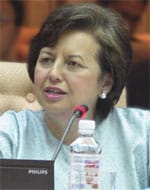Long one of Asias more stable emerging markets, Malaysia is ready for the next stage in its development.
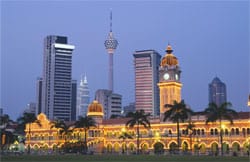
Pro-business policies allowed rapid development in cash-rich industriesalthough the government itself backed some industries that still cant compete. Capital injection into domestic infrastructure provided a strong base. Tourism, a major income earner, acts as an introduction to increasing numbers of visitors from areas such as the Middle East to Malaysias services, including education and health services. And in a world of high oil prices, the country is a net exporter of both oil and gas.
Currently, Malaysia is also a beneficiary of the China boom. Lee Kim Yew, head of the Malaysia-China Business Council, believes Malaysia will be exporting $50 billion worth of goods to the Asian economic giant within five to 10 years. This year, exports are tipped to put on 15% to reach $30 billion. At the same time, Malaysian firms are pumping cash into Chinas agriculture, tourism, mining, pharmaceutical and forestry sectors.
The country has not always had it easy, though. In 1989 Malaysia was hit by what became a four-year crisis, with the economy overheating due to large net capital inflowsand subsequent outflowswith high liquidity and inflation. But the economy escaped the worst of the East Asian economic crisis of 1997 that humbled many of its neighbors. Its actions to defend itself included controversial moves such constraints on capital transfers and a peg on the ringgit currency that is still in place today.
Through the economic ups and downs, Malaysias stable political environment and educated workforce kept it moving ahead. The government had enough cash to bankroll industries that could not have survived on their own. The most prominent example is the Proton car, protected by high import tariffs on imported automobiles.
Mohamed Ariff, executive director of the Malaysian Institute of Economic Research (MIER), says there are clear signs that the government is telling such firms that the days of coddling are over. The old policies wont work now under globalization. The place for protected industries has gone. The place for the Proton has gone. I believe in infant industry protection, but after 25 years is it still an infant? It still cant grow up? Proton is one; iron and steel, they are just not competitive. If they were competitive, they would not need protection, he says.
Zarir J. Cama, head of HSBC Bank Malaysia, believes the government has recognized that there is no longer grassroots support for expensive backing of industries with an uncertain future. As you move up the curve in development, the priorities of people change. The government is saying we have certain priorities; we have been elected for certain thingsnot necessarily a car, he says.
Higher on the list of priorities these days, says Cama, is good water and sanitation, and this is where the government will be spending economic pump-priming funds. It will no longer be spending big on infrastructure development because the job has been done, except in provinces that did not support the UMNO (United Malays National Organization) government. It is bringing forward some projects originally penciled in for 2006 to cushion the current downturn in the construction sector, Cama notes.
Supporters of the hands-on approach from government say it has allowed Malaysian industry to develop expertise it could not have achieved in any other way. Proton may not be able to stand on its own feet in an open market, but it has spawned an automotive components industry that can.
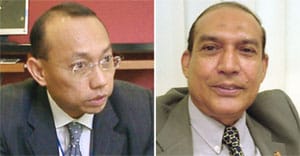
|
|
|
The new administration is trying to get back on the main stream and give a greater leeway to market forces, says MIERs Ariff. A relatively high budget deficit that came in at 4.5% last year is due for trimming, and subsidies on fuel and other protectionist measures are on the way out, albeit in stages, he says.
We keep on saying that it doesnt make economic sense, that people must pay for the scarcity value of a product. The government understands that, but politically it is not easy to remove them too soon, so the government is trying to remove them slowly, Ariff adds. Again, Malaysia has the flexibility that many other countries dont possess. In reserve-rich Malaysia, big deficits are easily covered by mainly domestic borrowing in an environment of high liquidity.
Yusil Mohamed Yusoff, CEO of Bursa Malaysia, formerly the Kuala Lumpur Stock Exchange, is confident that Malaysian companies can now compete in a far bigger marketplace. Its a logical step for Malaysian companies that have done well. Our population is only 23 million. If you have so much market share, you cant expand much further, so its quite natural for our companies to look beyond our borders, he says. Banks are moving to Indonesia and the Philippines, and securities house CIMB recently bought Singapore-based broker GK Goh. State oil company Petronas is active in as many as 35 countries.
MIERs Ariff says the new administration of Abdullah Badawi is determined to internationalize the Malaysian economy. We see China as a challenge, not as a threat but an opportunity, but weve got to move away from the collision course with China so weve got to realign, change direction a little bit and make our economy more complementary to China. We are going to go for niche areas where it will take China some time to catch up, he says.
In current terms this means biotechnology and nanotechnology. Critics who say that this is just another example of government wishful thinking point to earlier support for information technology industries that have not achieved targets. Of the IT experiment, HSBCs Cama says it is unfair to say it failed. The government-backed IT city, Cyberjaya, is impressive, he says, with a strong backbone underlying the infrastructure. HSBC is there. Weve got a magnificent office there. Its a processing center for all parts of the world, one of our seven or eight global sites, with approximately 2,000 people, he says.
HSBC would like to expand at Cyberjaya, but the countrys emerging problemscarce human resourcesis a barrier. There is general acknowledgement in the community that Malaysias early plus, its peoples facility in the English language, is eroding.
Says Cama: If you ask should you go in for nanotechnology and biotechnology, well, I guess countries have aspirations. These things are important for a country, to make these attempts. Malaysia might have a niche presence in biotech, so if I was sitting somewhere where I could take a decision on this, I would look at the particular strengths and concentrate on these and become a leader.
Ariff adds that Malaysia is pushing into the higher end of the spectrum in electronics, one of its main export industries. We are going into services. We want to make ourselves as complementary to China as we can, so we want to re-invent the economy. We are going to move away from unskilled labor-intensive, low-value-added activities into skilled, higher technology, higher added value, he says.
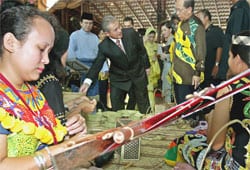
|
|
|
There are still plenty of wrinkles yet to be ironed out. The New Economic Policy, introduced after race riots in 1969, continues to discriminate in favor of indigenous Malays, at the expense of Chinese and Indian citizens. Bursa Malaysias Yusoff defends the policy. In the case of Malaysiamultiracial, multiculturalthe government has to have a balance on which way to go. If you have a balanced system, you will forego certain benefits of the free market system, but you avoid some of the problems that could accompany a free market system where you had some segments of the population advancing at a much faster pace than the others, he explains.
The free market system works well when you dont have to worry about a multiracial system. We recognize the sensitivity this creates. Perhaps you see a greater level of government intervention, but on the whole it has served the country very well. The question is, Do you have to do this forever? he asks. He believes the government recognizes the job has been done and is opening up bit by bit.
Political leaders, up to the Prime Minister himself, acknowledge that corruption is a problem. Yusoff spoke to Global Finance just as his exchange was under fire after a series of stock manipulations that saw banks pull their support for many market players, sending the market index plummeting. But such growing pains are the exceptions in what is generally an upbeat picture. Analysts agree that Malaysia has got its recipe right. Credit Suisse First Boston (CSFB) gave Malaysia a glowing report after a series of meetings with senior government officials and private sector operators at the end of May.
The report said that inflationary pressures were benign and that there was room for higher growth, with the investment-to-GDP rate at 27% still relatively subdued. Portfolio flows had picked up, and while it was impossible to tell how much of these flows were speculative, even if there is a wholesale reversal of these capital flows, Bank Negara Malaysia [the central bank] has adequate foreign exchange reserves to counter the drop in the monetary base, the CSFB report said.
While growth is likely to be down this year, the fundamentals remain strong. Ariffs own research group put first-quarter growth this year at 5.9%, well down on full-year 2004 growth of 7.1% and 7.8% in the first quarter of 2004, but enviable in many other economies. Clearly, Asias baby is growing up.
|
|||
|
Malaysia Aims for Global Role in Islamic Banking
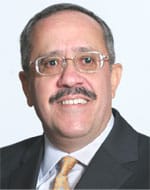
|
|
|
In three short years, partly through Camas enthusiasm and a concerted effort from both the government and the private sector, Islamic finance has grown from a bit-part to a major starring role in Malaysias banking sector.
Weve moved down that curve very smartly, very strongly, in terms of the government absolutely believing that it can take this opportunity, says Cama. In Malaysia today a little over 11% of our total balance sheet is Islamic. When I came that figure was 0.2%. After two years our balance sheet is RM38 billion to RM40 billion.
Cama believes there is more upside to come. He knows Malaysia cant hope to handle all the emerging business in the fast-growing sector, but there are niche markets within the overall Islamic finance sector where Malaysia does have a unique opportunity. HSBC itself, he says, has played a dual role. First, it participates actively in the market, developing products for commercial gain. The other, equally critical part of his work has been to participate with government and regulators to build the infrastructure, the laws, the regulatory structures, the legal system that surrounds it. This business cannot exist in a vacuum, he explains.
A benign view and will on the part of government has been an essential ingredient. Cama praises the approach of Malaysias leadership: The regulators here, the government, the central bankthe governor is the championthey are pragmatic people, they say they require building blocks, and they are asking people what they need. On the publics side, he says, there is no shortage of people who believe in Islamic finance.
Taxi driver Sulaiman Hamid is among them. I feel far happier that my housing mortgage is based on Islamic financial principles, he says. It actually costs me a little more than a traditional mortgage, but the sense of having done the correct thing is very important. Its not only Malaysias Muslims who are getting benefit from the fast-developing Islamic finance sector, with many other investors helping push it to second place in the world after the Middle East.
Bonds are a fast-growing market. Global issuance of bonds, known as sukuk, reached $6.7 billion last year, up more than four times on the 2003 figure. In the first half of this year, sukuk issues stood close to $6 billion. Some of those issues were listed on the Malaysian exchange.
Yusil Mohamed Yusoff, CEO of Bursa Malaysia, is upbeat on Islamic finance. At the moment, Islamic assets make up 10% to 15% of total issues on the Malaysian exchange. The domestic market is quickly adopting shariah finance systems, he says, adding that theres a lot of room to grow when you think that half of the population is Muslim. Around half of the bonds issued on Malaysian markets are Islamic, recognizing that this is one of the most developed markets for bonds. Recently an arm of the World Bank issued bonds on the Malaysian exchange.
While growth in the bourses Islamic market has been strong, Yusoff warns that Malaysias niche play is under threat. Some Muslim investors say Malaysias shariah rules vary from the orthodox, but the bourse chief says the criteria are adequate for most investors, and Middle East issues are very welcome on his market. We want to pursue the growth of Islamic capital markets, [and] what would be even nicer for us would be to get some of those Muslim issues, he says. More Middle Eastern visitors represent a strong positive for Malaysia.
Much of the legal and regulatory infrastructure praised by Cama has been the work of the governor of Bank Negara Malaysia, Zeti Akhtar Aziz. She says, In many countries where Islamic finance exists, it manifests itself in banking mainly, but we have the whole infrastructure, including the financial markets, the money market, which allows flexibility in the management of funds, the bond market, the equities market.
We have the legal infrastructure; we have all the legislation in place; we have the supervisory and regulatory framework in place; we have Islamic insurance growing significantly, says Zeti. In all these areas, and all our specialized institutions like our mortgage corporation that issues mortgage papers, securitized from the banking system, this all allows the financial services to function as a form of financial intermediation across the board, she notes.
All Malaysian banks now have growing Islamic finance arms, and some are joining with institutions overseas to establish Islamic operations that build on the Malaysian infrastructure. Zeti is one who believes there is much more Malaysia can do to establish itself in Islamic finance. The comprehensive nature [of Malaysias Islamic services]and because the volume is increasing and because the infrastructure is in placeincreases the potential for Malaysia to be a hub for Islamic financial services, she says.
Keith Loveard
